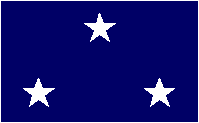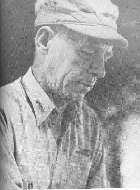

| Vice-Admiral
Frederick Carl Sherman
Born: ? Died: ? Nickname: "Ted" |
 |
However, despite his efforts, his ship, hardly manoeuverable and a big target, was hit by Japanese bombers during the Battle of the Coral Sea, finally causing her loss. Sherman reluctantly ordered her abandoned and went over the side as the last living person, and out of a job.
However,
he was not to wait too long for a new assignment. Promoted to Rear-Admiral,
half a year after the loss of Lexington Sherman hoisted his flag
as replacement of Admiral Kinkaid on Enterprise. Conducting trials
in two-carrier operations, a novum in US Navy operations (the employment
of Yorktown and Lexington together was by accident, merely,
and Enterprise and Hornet had divided up before the Battle
of Midway.)
Sherman was again out of
a job when Enterprise departed for an overhaul on 28 April 1943,
as her replacement was British carrier Victorious.
However, he stayed in the South Pacific and was placed on Vice-Admiral Aubrey Fitch's COMAIRSOPAC office on Halsey's behalf. Halsey knew that Sherman deserved a carrier command, and recommended Sherman as commander of one of the new carrier forces at Pearl Harbor. Sherman was transfered to Pearl Harbor and became COMCARDIV2, on board Essex, on 7th June 1943. Together with the still operating Enterprise, Sherman conducted additional two-carrier formation operations until Enterprise departed for the States and repairs. It was a short stop only, for on 16 July already, Sherman was send back to the South Pacific as COMCARDIV1, on Saratoga, the other available carrier.
Once there,
however, Sherman merely sat around training and operating and training
again, first with HMS Victorious, then with battleships and cruisers.
Better times would come for the Admiral, beginning with the Octobet arrival
of USS Princeton, a new light carrier.
And Sherman
was about to return were he had almost been one and a half year before,
to the Japanese fortress at Rabaul. Halsey's forces had invaded the northernmost
Solomons island, Bougainville, on November 1st. The night of the next day,
Japanese forces under Admiral Omori attacked the US forces covering the
landings, and were repulsed by Admiral A. Stanton Merrill, loosing a light
cruiser and destroyer. Other ships, however, were waiting. As Omori returned
to Rabaul, Vice-Admiral Kurita Takeo joined up with seven Heavy Cruisers,
one light cruiser, and four destroyers. Halsey, knowing that his forces
would not be able to stop that force should it run south under cover of
night, and that it would be impossible to wait with air attacks from Shermans
carriers until then, dispatched the Admiral and his forces north immediately
for an all out strike against Rabaul - risking the loss of the venerable
Saratoga, old and hardly manoueverable, and the small Princeton.
Sherman's planes descended on Rabaul shortly before midday on November 5th, 97 planes from a complement of 112 planes on the two carriers. The attack was a decisive success, though no enemy cruisers were sunk, the force was throughly damaged and retired to Truk soon thereafter.
Sherman
repeated the strike shortly thereafter, with less success. But he had proven
the feasibility of the attack against naval bases even in the light of
concentrated defenses.
Sherman,
still COMCARDIV1, took over command of TG 58.3 during the 1944 Gilbert
and Marshall operations, his flag flying from Bunker Hill. Not long,
however, since he was relieved and put on leave for recreation - having
served at sea since early 1943 - in March, 1944, being placed into the
office of Commander Fleet Air West Coast.
Sherman returned as COMCARDIV1 exchanging jobs with Rear-Admiral Harrill on August 1st, 1944. On 12th August, he relieved Monty Montgomery as COMTG58.3. Sherman was back in his element. He first conducted attacks against the Visaya Islands, hitting them on 31st August supported by Rear-Admiral Davison. He and his task group were then used in attacking the island of Formosa, accompanied by the whole of Halsey's Third Fleet. In a seven-day battle, the US forces shot down 600 Japanese aircraft while loosing ninety of their own. The Japanese air forces lost two-thirds of their air cover for the Leyte operations.
Sherman's task group was one of three task groups available to Admiral Halsey in the essential three days of the Battle of the Leyte Gulf. His forces, situated all too well for air strikes, east of Luzon and not too far away, were hit relentlessly by Japanese planes, and the light carrier Princeton, in Sherman's group, was sunk by a Japanese dive-bomber. Sherman then united his forces with Halsey's remaining two carrier groups and headed north, were his units attacked Admiral Ozawa Jisaburo's Deception Force near Cape Engaño. After concluding this operations more or less successfully, and after seeing that the Japanese would not start another attempt to attack the landing force off Leyte, Sherman was ordered to Ulithi to replace his airgroups On 28th October. His leave was cut short when false reports of a Japanese movement toward the Leyte beaches reached the fleet on November 1st, and Sherman headed north again to support Admiral Bogan.
Sherman's, Montgomery's and Bogan's planes struck Philippines airfields on 5th and 6th November, and when Admiral McCain, who was now COMTF38, had his flagship hit and its replacement headed to Ulithi, he was temporarily given command of the Task Force.
After spending two months in Ulithi, and conducting maneuvers, TF 38 sortied again on December3 30 1944 in support of the largest Pacific landing to date, the invasion of Luzon, at Lingayen Bay. The Fast Carriers and Sherman's TG roamed the seas, striking air fields, conducting fighter sweeps, and attacking related targets. After successfully concluding these operations, Halsey and TF38 stayed on the western side of the Philippines, striking Cam Ranh in mid-January, Sherman commanding two TGs.
In February 1945, Sherman remained COMTG58.3, Mitscher taking back over from Halsey, despite his scheduled leave, as experienced TG commanders were scarce. In this job, Sherman supported the Iwo Jima landings, during which operation TF58 also struck Tokyo, the first carrier strike against the capital since the attacks exactly two years, ten months, and two days earlier.
Another
visit was paid in March, along with strikes on airfields on Kyushu, and
sucessive support of the operations against Okinawa and the support of
the landings there.
Following more regular and
unspectecular tasks as COMTG58.3, finally Sherman was in for a well deserved
promotion. On June 14, 1945, he was informed that he was to get thirty
days leave, a promotion to Vice-Admiralcy, and command over the 1st Fast
Carrier Force (see: Tactics, once completed). Sherman was not to have war-time
fleet command, his leave ending only after the war had ended. In the post-war
period, Sherman first assumed command of both Fast Carrier Forces, then
of the 5th Fleet as a whole. But his qualities were not needed in the post-war,
peacetime Navy, and Sherman retired in 1947.
Sherman
deserves special credit. He led fast carriers from 1942 to 1945, proved
outstanding at Rabaul, Leyte, and Okinawa, and was not only a fighter but
also a thoughtful man. He was unjustly left out of the promotion cycle
several times, which denied him the chance to command TF38/58 and instead
placed the incapable McCain in said post.